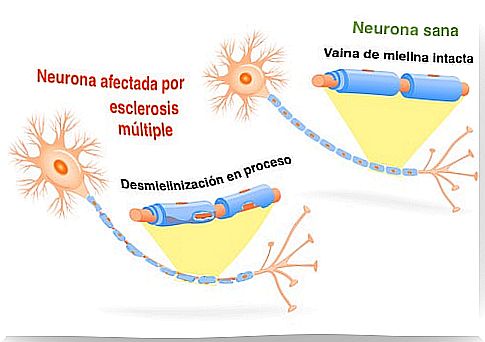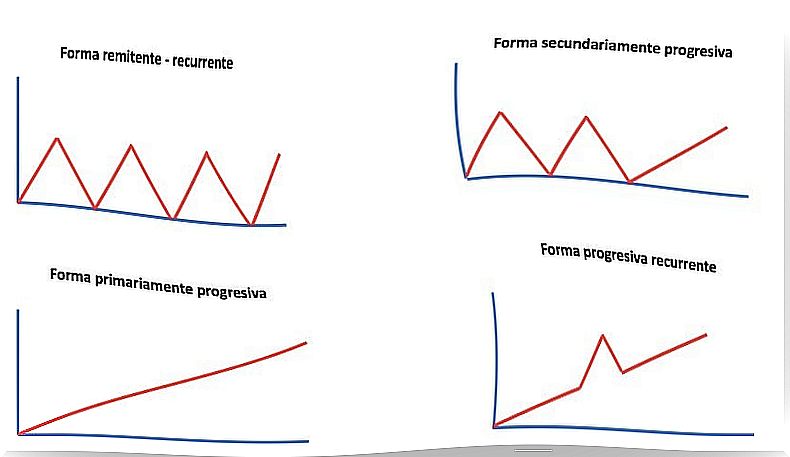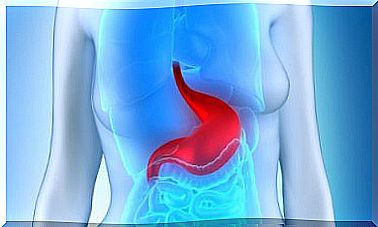Multiple Sclerosis
Multiple sclerosis is the most common demyelinating disease affecting the central nervous system.

Multiple sclerosis is a chronic disease, with highly variable symptoms that evolve differently in each case. To be more specific, it is a demyelinating neurological disease that affects the central nervous system (CNS).
It is characterized by the appearance of plaques or areas in which myelin disappears in the CNS. In fact, myelin is the substance that envelops and protects the axons of neurons.
Its main function is to increase the speed of transmission of nerve impulses. In addition, its disappearance explains the most characteristic features of this disease.

In addition, an infiltrate of inflammatory cells appears in these plaques:
- On the one hand, CD4 T lymphocytes and macrophages in acute lesions.
- On the other hand, CD8 T lymphocytes and B lymphocytes in older plaques.
However, there is no correlation between the number and size of these plaques and symptoms.
Depression in patients with multiple sclerosis is very common, especially at the time they receive the diagnosis of the disease.
Who is affected by multiple sclerosis?

- First, it affects women more than men and has a greater impact on Caucasians.
- On the other hand, it usually makes its debut between the ages of 20-40.
- In addition, it follows a certain geographical distribution.
- Finally, the prevalence is higher in countries far from Ecuador, being especially high in the Nordic countries.
The latest evidence points to a significant environmental influence. Vitamin D and heat are protective factors, which would explain, in part, the geographic distribution of the disease.
How is it produced?
Regarding genetics , an association with the human leukocyte antigens HLA-DR2 and HLA-DQ has been demonstrated. In addition, the disease is more frequent in direct relatives of sclerosis patients than in the rest of the population.
Clinical manifestations of multiple sclerosis

Neurological symptoms
The most frequent (61%) are sensitive symptoms. Within these, paresthesia (annoying tingling sensation) or hypoesthesia may appear, reducing sensitivity in an area.
In young patients it is common for the disease to begin as optic neuritis , usually retrobulbar. In these cases, blurred vision and pain appear when performing eye movements with a normal fundus. In fact, in a young patient who complains of unilateral vision loss, multiple sclerosis should be ruled out.
First motor neuron weakness and motor symptoms appear almost as often as optic neuritis. They are a consequence of the injury to the pyramidal tract.
In spinal cord injuries, other symptoms are common, such as urgency and impotence. Lhermitte’s sign, a painful electric shock sensation when flexing the neck , may appear in cervical injuries.
Another symptom may be double vision, and due to cerebellar injury, difficulty articulating words, incoordination, nystagmus, and tremors may appear .
In advanced cases, neurological dysfunction manifested as memory loss is relatively frequent. In these phases, behavior can also be altered, appearing euphoria and disinhibition.
Depression in these patients is very common, but it is reactive, not caused by the disease per se.
Evolutionary patterns
Multiple sclerosis can progress in one of the following patterns.
Sender form – recurring (RR)
In 85% of cases the disease evolves following this pattern. Outbreaks occur that remit without sequelae, returning to the initial baseline situation.
Secondarily progressive form
After a period of evolution in the form of outbreaks, the symptoms begin to progress.
Primarily progressive form
In 10% of cases the disease follows a progressive course from the first moment, without experiencing outbreaks. It has a bad prognosis.
Progressive form – recurring
It occurs only in 5% of cases. The disease follows a progressive course from the beginning, although in this case there are outbreaks of exacerbation of symptoms.

To this day there is no treatment that cures the disease. Current treatments follow two routes: on the one hand, alleviate the symptoms of outbreaks, and on the other hand, modify the course of the disease.
In addition, there are also drugs aimed at treating the symptoms of the sequelae.
- Treatment of acute outbreaks is done with mega doses of corticosteroids. The regimen and route of administration will depend on the severity of the outbreak.
- Immunomodulators are used to modify the course of the disease. Glatiramer acetate and beta interferon are the first-line drugs. Natalizumab and fingolimod are second-line drugs, the former being the most effective currently available.
The high rate of depression in these patients explains the need for good psychological support, in addition to drug treatment, a good diet, and other issues.









